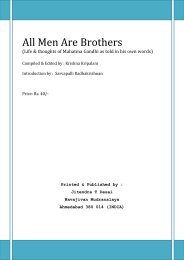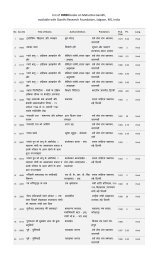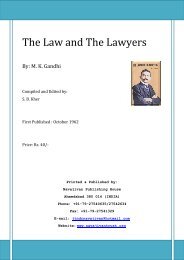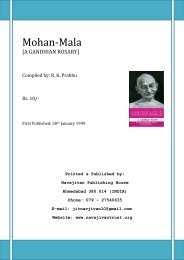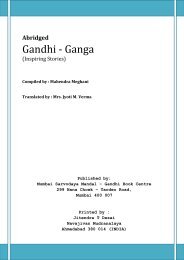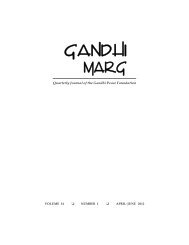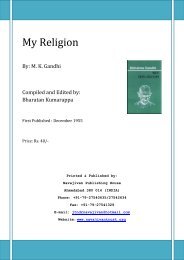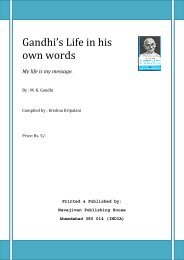- Page 2:
PREFACEIt is quite befitting that a
- Page 6:
Prefaceiiithis volume. It was kind
- Page 10:
4 Contextualising Gandhian Thoughtw
- Page 14:
6 Contextualising Gandhian ThoughtE
- Page 18:
10 Contextualising Gandhian Thought
- Page 22:
12 Contextualising Gandhian Thought
- Page 26:
14 Contextualising Gandhian Thought
- Page 30:
16 Contextualising Gandhian Thought
- Page 34:
18 Contextualising Gandhian Thought
- Page 38:
20 Contextualising Gandhian Thought
- Page 42:
22 Contextualising Gandhian Thought
- Page 46:
24 Contextualising Gandhian Thought
- Page 50:
26 Contextualising Gandhian Thought
- Page 54:
28 Contextualising Gandhian Thought
- Page 58:
1. Francis Fukuyama, The End of His
- Page 62:
32 Contextualising Gandhian Thought
- Page 66:
34 Contextualising Gandhian Thought
- Page 70:
36 Contextualising Gandhian Thought
- Page 74:
38 Contextualising Gandhian Thought
- Page 78:
40 Contextualising Gandhian Thought
- Page 82:
42 Contextualising Gandhian Thought
- Page 86:
44 Contextualising Gandhian Thought
- Page 90:
1. Young India, August 11, 1920.2.
- Page 94:
48 Contextualising Gandhian Thought
- Page 98:
50 Contextualising Gandhian Thought
- Page 102:
52 Contextualising Gandhian Thought
- Page 106:
54 Contextualising Gandhian Thought
- Page 110:
56 Contextualising Gandhian Thought
- Page 114:
58 Contextualising Gandhian Thought
- Page 118:
60 Contextualising Gandhian Thought
- Page 122:
62 Contextualising Gandhian Thought
- Page 126:
64 Contextualising Gandhian Thought
- Page 130:
66 Contextualising Gandhian Thought
- Page 134:
68 Contextualising Gandhian Thought
- Page 138:
70 Contextualising Gandhian Thought
- Page 142:
72 Contextualising Gandhian Thought
- Page 146:
74 Contextualising Gandhian Thought
- Page 150:
76 Contextualising Gandhian Thought
- Page 154:
78 Contextualising Gandhian Thought
- Page 158:
80 Contextualising Gandhian Thought
- Page 162:
82 Contextualising Gandhian Thought
- Page 166:
84 Contextualising Gandhian Thought
- Page 170:
86 Contextualising Gandhian Thought
- Page 174:
88 Contextualising Gandhian Thought
- Page 178:
90 Contextualising Gandhian Thought
- Page 182:
92 Contextualising Gandhian Thought
- Page 186:
1. Navajivan, November 20, 1920.2.
- Page 190:
96 Contextualising Gandhian Thought
- Page 194:
98 Contextualising Gandhian Thought
- Page 198:
100 Contextualising Gandhian Though
- Page 202:
102 Contextualising Gandhian Though
- Page 206:
104 Contextualising Gandhian Though
- Page 210:
106 Contextualising Gandhian Though
- Page 214:
108 Contextualising Gandhian Though
- Page 218:
110 Contextualising Gandhian Though
- Page 222:
1. Johan Galtung, Violence, Peace a
- Page 226:
116 Contextualising Gandhian Though
- Page 230:
118 Contextualising Gandhian Though
- Page 234:
120 Contextualising Gandhian Though
- Page 238:
122 Contextualising Gandhian Though
- Page 242:
124 Contextualising Gandhian Though
- Page 246:
126 Contextualising Gandhian Though
- Page 250:
128 Contextualising Gandhian Though
- Page 254:
130 Contextualising Gandhian Though
- Page 258:
132 Contextualising Gandhian Though
- Page 262:
134 Contextualising Gandhian Though
- Page 266:
136 Contextualising Gandhian Though
- Page 270:
138 Contextualising Gandhian Though
- Page 274:
140 Contextualising Gandhian Though
- Page 278:
142 Contextualising Gandhian Though
- Page 282:
144 Contextualising Gandhian Though
- Page 286:
146 Contextualising Gandhian Though
- Page 290:
148 Contextualising Gandhian Though
- Page 294:
150 Contextualising Gandhian Though
- Page 298:
152 Contextualising Gandhian Though
- Page 302:
1. Harijan, August 29, 1936.2. Youn
- Page 306:
156 Contextualising Gandhian Though
- Page 310:
158 Contextualising Gandhian Though
- Page 314:
160 Contextualising Gandhian Though
- Page 318:
162 Contextualising Gandhian Though
- Page 322:
164 Contextualising Gandhian Though
- Page 326:
166 Contextualising Gandhian Though
- Page 330:
168 Contextualising Gandhian Though
- Page 334:
170 Contextualising Gandhian Though
- Page 338:
172 Contextualising Gandhian Though
- Page 342:
174 Contextualising Gandhian Though
- Page 346:
176 Contextualising Gandhian Though
- Page 350:
178 Contextualising Gandhian Though
- Page 354:
180 Contextualising Gandhian Though
- Page 358:
182 Contextualising Gandhian Though
- Page 362:
184 Contextualising Gandhian Though
- Page 366:
186 Contextualising Gandhian Though
- Page 370:
188 Contextualising Gandhian Though
- Page 374:
3Gandhi's Theory of Trusteeship:An
- Page 378:
Gandhi's 'Theory of Trusteeship…
- Page 382:
Gandhi's 'Theory of Trusteeship…
- Page 386:
Gandhi's 'Theory of Trusteeship…
- Page 390:
Gandhi's 'Theory of Trusteeship…
- Page 394:
Gandhi's 'Theory of Trusteeship…
- Page 398:
Gandhi's 'Theory of Trusteeship…
- Page 402:
Gandhi's 'Theory of Trusteeship…
- Page 406:
Gandhi's 'Theory of Trusteeship…
- Page 410: Gandhi's 'Theory of Trusteeship…
- Page 414: Gandhi's 'Theory of Trusteeship…
- Page 418: Gandhi's 'Theory of Trusteeship…
- Page 422: Gandhi's 'Theory of Trusteeship…
- Page 426: Gandhi's 'Theory of Trusteeship…
- Page 430: Gandhi's 'Theory of Trusteeship…
- Page 434: Gandhi's 'Theory of Trusteeship…
- Page 438: Gandhi's 'Theory of Trusteeship…
- Page 442: Gandhi's 'Theory of Trusteeship…
- Page 446: Gandhi's 'Theory of Trusteeship…
- Page 450: Gandhi's 'Theory of Trusteeship…
- Page 454: 1. Harijan, December 16,1939.10112.
- Page 458: 49. Harijan, April 25, 1940.50. Ibi
- Page 464: 237 Contextualising Gandhian Though
- Page 468: 239 Contextualising Gandhian Though
- Page 472: 241 Contextualising Gandhian Though
- Page 476: 243 Contextualising Gandhian Though
- Page 480: 245 Contextualising Gandhian Though
- Page 484: 247 Contextualising Gandhian Though
- Page 488: 249 Contextualising Gandhian Though
- Page 492: 251 Contextualising Gandhian Though
- Page 496: 253 Contextualising Gandhian Though
- Page 500: 255 Contextualising Gandhian Though
- Page 504: 257 Contextualising Gandhian Though
- Page 508: The ContributorsJohn S. Moolakkattu
- Page 512:
The Contributors 5on Sr. Fulbright




